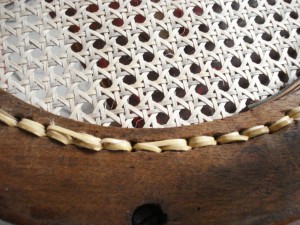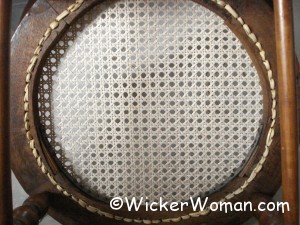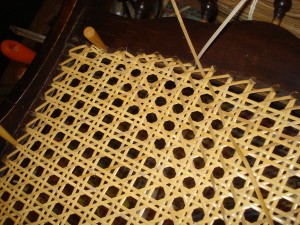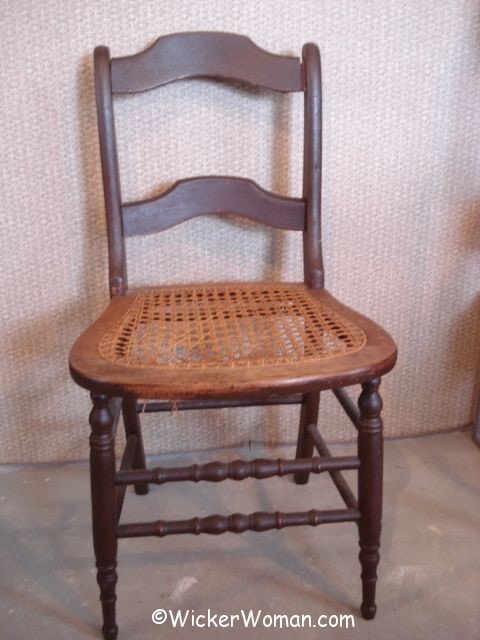Whether the seat is round, trapezoidal or horseshoe-shaped, several of us “old-timers” have learned how to take shortcuts and use the strands of cane to their best advantage and are sharing our techniques.

The how and why of skipping holes
Occasionally I will skip a hole and go into another one nearby to complete that diagonal row, so as not to have to cut a very long strand of cane.
This practice is not recommended for use very often as it is confusing to the novice and can get messy if used improperly. But I’ve been at this caning craft for over 35 years and feel confident I can pull it off.
The picture below is of the bottom of a round cane chair and if you look closely you can see that I skipped at least two holes here and maybe even three times. And notice also that there are no knots on the underside of my cane chairs because I use the ending of the cane strands.

Then too, another trick is to skip entire diagonal rows, to best use your cane strands. Here’s a picture of what I’m talking about, although it might not be too clear. But as you’ll see, I can begin weaving in the top left corner with a new strand or continue weaving at the top-right if I wish.
I will be taking more pictures of the cane chair I’m working on now, and will make sure to explain both the “skipping holes” and the “skipping rows” techniques of speeding up your strand cane weaving and making optimum use of the cane in future blog posts.
Check out the Chair Caning Instructions page for complete directions on weaving your first hand caned chair seat! Stay tuned for more!





My square chair does not have corner holes due to chair leg. How to cane in that instance?
Thank you.
Hi Sarah,
I’m not too sure what kind of chair you have but with some cases, the seat can be popped up after releasing the glue, giving access to those corner holes.
If this is not the case with your chair, then you will need to glue in the ends of the cane for the diagonals into the holes. It’s the same process as doing blind caning where the holes are not drilled completely through the frame.
How did the previous weaver handle this situation?
Whoops! I misread your post! There are NO HOLES at all in the corners of your chair, correct? In that case, take a look at whatever the previous caner did and try to follow their technique.
Otherwise, what I’ve done in many cases is to make two “corner” holes, one on each side of the leg and put fish-heads in each one. Fish heads=two diagonals from the same direction going into one hole.
I’m weaving a upright chair back how do I I tie off the loose strands so the back looks neat and tidy as well as the front I’m a complete novice an d half way through stage three thanks
Hi John,
How nice to hear you are weaving your first cane chair. I hope it’s a relatively simple chair seat and not a round seat, like the one I started on! It took me well over 12 hours to weave my first cane chair seat!
Did you miss seeing the Chair Caning Instructions page where I go into great detail about using my “No-Knot Method of Tying Off” cane strands? There are photographs and a video showing the method I started using way back in the 1970s when I discovered when removing the old cane seat from a chair made in 1880s.
It’s a really cool technique in that there are no-knots on the bottom side of the seat. This method can be easily used for the caning the backs of any other kind of chair or rocker, it’s an especially good treatment for Lincoln rockers!
Good luck on your chair caning adventures and be sure to read all the Articles on that page where you can get some more great chair caning, seatweaving and wicker repair hints, tips and techniques!